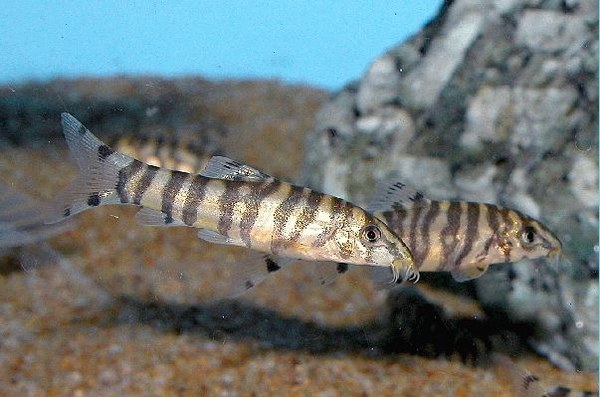Botia rostrata
Summary
Scientific Name: Botia rostrata (Günther, 1868 )
Common name: Twin-banded Loach, Ladder Loach, Dohser (India), Gangetic Loach (India), Sergeant Major Loach
Synonyms: Botia dayii, Botia geto.
(above: adult with reticulated markings & colourful fins)
Distribution: India, Bangladesh, also Salween and Irrawaddy basin in China.
Sexual Dimorphism: Females generally plumper all over than males and can get extremely fat when full of eggs.
Maximum size: 8 inches (20cm).
Similar to: Botia almorhae, Botia kubotai.

(above: juveniles with twin bar markings)
Care: In nature, the fish live in calmer water pool areas of highland streams. The tank should include lots of hiding places amongst rocks and driftwood. Excellent diggers that appreciate a sand substrate to protect the delicate barbels. Lighting should be subdued.
Feeding: Good quality flake, sinking pellets, algae wafers, chopped earthworms, thawed frozen Bloodworm, Mysis Shrimp, chopped Cocktail Shrimp. Avoid over-feeding.
Water parameters: pH:6.5-7.5 Hardness: Medium Max dh: 12
Temperature: 76ºF to 82ºF(22-27.7°C)
Breeding: Not bred in aquaria.
Notes
 Botia rostrata is a generally peaceful loach that is rarely available. However, lately they are being bred in Europe, probably by hormone induction, so are more frequently available. They should be kept in a group of their own species. Like other Botia, they have a social structure, and a certain amount of in-fighting will be seen. For this reason, provide numerous hiding places so that less dominant fish may escape the attentions of more boisterous individuals. During times of fighting or sometimes at feeding time, a pair of fish may "gray out." The base colour will darken considerably, changing the contrast between the markings and the regular body colour. Body markings can be very variable in this species, and there is a marked difference between juveniles and adults (adult above). The most common feature is the twin-barred effect with a grey to grey/blue infill between the bars.
Botia rostrata is a generally peaceful loach that is rarely available. However, lately they are being bred in Europe, probably by hormone induction, so are more frequently available. They should be kept in a group of their own species. Like other Botia, they have a social structure, and a certain amount of in-fighting will be seen. For this reason, provide numerous hiding places so that less dominant fish may escape the attentions of more boisterous individuals. During times of fighting or sometimes at feeding time, a pair of fish may "gray out." The base colour will darken considerably, changing the contrast between the markings and the regular body colour. Body markings can be very variable in this species, and there is a marked difference between juveniles and adults (adult above). The most common feature is the twin-barred effect with a grey to grey/blue infill between the bars.
See also: Botia rostrata - Development of Markings During Growth
Photo Gallery
Click to view all images of this species! |
Document Actions


